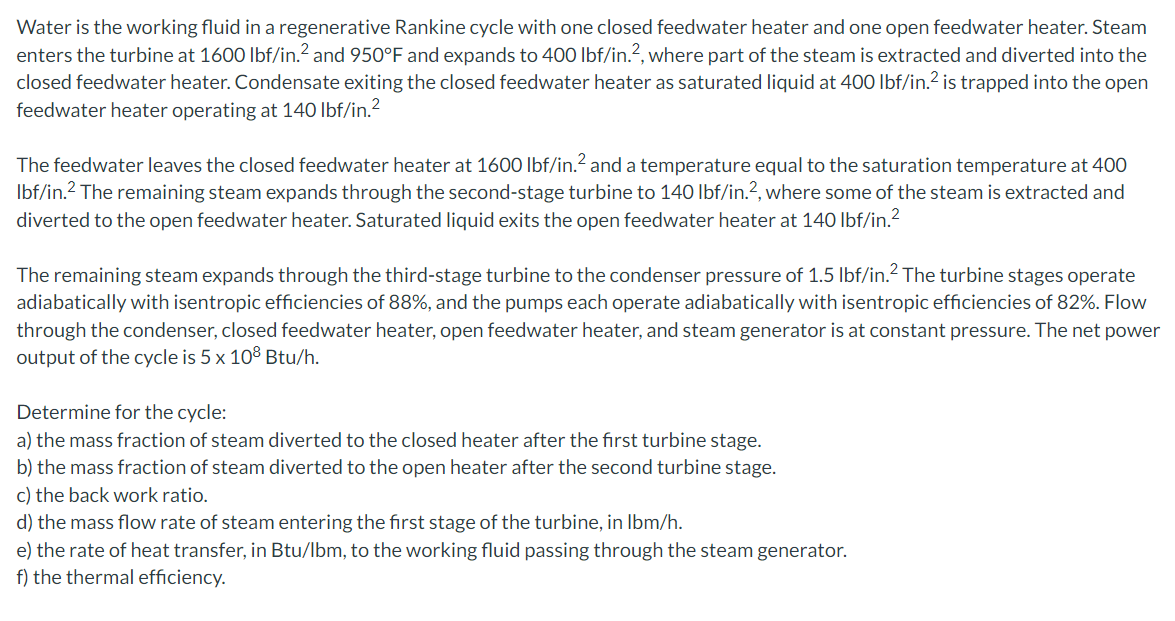Determine for the cycle: a) the mass fraction of steam diverted to the closed heater after the first turbine stage. b) the mass fraction of steam diverted to the open heater after the second turbine stage. c) the back work ratio.
Determine for the cycle: a) the mass fraction of steam diverted to the closed heater after the first turbine stage. b) the mass fraction of steam diverted to the open heater after the second turbine stage. c) the back work ratio.
Elements Of Electromagnetics
7th Edition
ISBN:9780190698614
Author:Sadiku, Matthew N. O.
Publisher:Sadiku, Matthew N. O.
ChapterMA: Math Assessment
Section: Chapter Questions
Problem 1.1MA
Related questions
Question

Transcribed Image Text:Water is the working fluid in a regenerative Rankine cycle with one closed feedwater heater and one open feedwater heater. Steam
enters the turbine at 1600 lbf/in.2 and 950°F and expands to 400 lbf/in.?, where part of the steam is extracted and diverted into the
closed feedwater heater. Condensate exiting the closed feedwater heater as saturated liquid at 400 lbf/in.2 is trapped into the open
feedwater heater operating at 140 lbf/in.2
The feedwater leaves the closed feedwater heater at 1600 lbf/in.? and a temperature equal to the saturation temperature at 400
Ibf/in.2 The remaining steam expands through the second-stage turbine to 140 lbf/in.?, where some of the steam is extracted and
diverted to the open feedwater heater. Saturated liquid exits the open feedwater heater at 140 lbf/in.?
The remaining steam expands through the third-stage turbine to the condenser pressure of 1.5 lbf/in.? The turbine stages operate
adiabatically with isentropic efficiencies of 88%, and the pumps each operate adiabatically with isentropic efficiencies of 82%. Flow
through the condenser, closed feedwater heater, open feedwater heater, and steam generator is at constant pressure. The net power
output of the cycle is 5 x 108 Btu/h.
Determine for the cycle:
a) the mass fraction of steam diverted to the closed heater after the first turbine stage.
b) the mass fraction of steam diverted to the open heater after the second turbine stage.
c) the back work ratio.
d) the mass flow rate of steam entering the first stage of the turbine, in Ibm/h.
e) the rate of heat transfer, in Btu/lbm, to the working fluid passing through the steam generator.
f) the thermal efficiency.
Expert Solution
This question has been solved!
Explore an expertly crafted, step-by-step solution for a thorough understanding of key concepts.
This is a popular solution!
Trending now
This is a popular solution!
Step by step
Solved in 3 steps with 6 images

Knowledge Booster
Learn more about
Need a deep-dive on the concept behind this application? Look no further. Learn more about this topic, mechanical-engineering and related others by exploring similar questions and additional content below.Recommended textbooks for you

Elements Of Electromagnetics
Mechanical Engineering
ISBN:
9780190698614
Author:
Sadiku, Matthew N. O.
Publisher:
Oxford University Press

Mechanics of Materials (10th Edition)
Mechanical Engineering
ISBN:
9780134319650
Author:
Russell C. Hibbeler
Publisher:
PEARSON

Thermodynamics: An Engineering Approach
Mechanical Engineering
ISBN:
9781259822674
Author:
Yunus A. Cengel Dr., Michael A. Boles
Publisher:
McGraw-Hill Education

Elements Of Electromagnetics
Mechanical Engineering
ISBN:
9780190698614
Author:
Sadiku, Matthew N. O.
Publisher:
Oxford University Press

Mechanics of Materials (10th Edition)
Mechanical Engineering
ISBN:
9780134319650
Author:
Russell C. Hibbeler
Publisher:
PEARSON

Thermodynamics: An Engineering Approach
Mechanical Engineering
ISBN:
9781259822674
Author:
Yunus A. Cengel Dr., Michael A. Boles
Publisher:
McGraw-Hill Education

Control Systems Engineering
Mechanical Engineering
ISBN:
9781118170519
Author:
Norman S. Nise
Publisher:
WILEY

Mechanics of Materials (MindTap Course List)
Mechanical Engineering
ISBN:
9781337093347
Author:
Barry J. Goodno, James M. Gere
Publisher:
Cengage Learning

Engineering Mechanics: Statics
Mechanical Engineering
ISBN:
9781118807330
Author:
James L. Meriam, L. G. Kraige, J. N. Bolton
Publisher:
WILEY